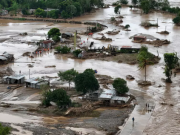I. Introduction
A. Definition and Significance of the Rainy Season
The rainy season, also known as the wet or monsoon seasons, is characterized by increased precipitation and humidity in a particular region. Influenced by various factors such as climate, geographical location, and prevailing wind patterns, this seasonal weather pattern, particularly the rainy season, plays a vital role in shaping many regions’ environments, agriculture, and economies globally.

In countries with distinct wet and dry seasons, such as the Philippines, the rainy season often brings relief from extended periods of drought; and significantly contributes to the restoration of water sources. It promotes plant growth, rejuvenates ecosystems, and sustains agricultural activities – all affecting the local economy, including the real estate sector.
B. Overview of the Real Estate Industry and its Sensitivity to Environmental Factors
Real estate is a vast industry that involves property acquisition, development, management, sale, or rental. It is a sector determined by several external factors, including economic conditions, demographic trends, and environmental considerations.
Environmental factors play a crucial role in shaping the real estate market. These factors include but are not limited to climate, proximity to natural resources, and exposure to natural hazards. The real estate industry is uniquely sensitive to environmental conditions as they can significantly impact property value, market demand, and the overall feasibility of development projects.
Climate-related factors, such as the rainy season, have short-term and long-term effects on the real estate industry. The impact can range from immediate challenges encountered during property construction and maintenance to broader implications on market activity, pricing, and transactional dynamics. Understanding and addressing these effects are essential for industry professionals to make informed decisions and develop strategies to adapt to changing weather patterns.
C. Purpose of the Article
We at HousingInteractive, understand that external factors such as weather and climate highly impact the real estate industry in every aspect. The purpose of this article is to provide a comprehensive analysis of how the rainy season affects the real estate industry. By examining historical data, empirical evidence, and industry insights, we aim to uncover the scientific and data-backed relationship between the rainy season and various aspects of the real estate market. This article intends to shed light on the impact of the rainy season on property construction, development, maintenance, and transactions, while also exploring strategies and initiatives focused on enhancing the industry’s resilience in the face of changing weather patterns.
Through this article, real estate professionals, investors, homeowners, and other stakeholders can gain valuable insights into the implications of the rainy season on their respective roles and responsibilities. Furthermore, we aim to promote awareness of the importance of considering climate-related factors in real estate decision-making processes and encourage the assumption of sustainable and resilient practices in the industry.
Next, we will explore the relationship between the rainy season and the real estate market, examining historical data and analyzing the correlation between rainfall patterns and housing demand/supply.
II. The Relationship Between Rainy Season and Real Estate Market
A. Historical Data on the Impact of Rainy Seasons on Real Estate
Examining historical data provides valuable insights into the impact of the rainy season on the real estate market. Research and analysis of past trends reveal patterns and correlations that help us understand the relationship between rainfall and the dynamics of the real estate industry.
Studies have shown the positive and negative effects of the rainy season on the real estate market. In regions where water scarcity is a concern, the arrival of the rainy season often leads to an increase in property demand; this is because ample water supply becomes available, alleviating worry about scarcity and enhancing the desirability of properties with access to water resources. Additionally, agricultural regions heavily reliant on rainfall may experience an increase in demand for properties suitable for farming or agricultural purposes.
Conversely, the rainy season can negatively impact the real estate market in areas prone to flooding or inadequate drainage systems. Flood-related risks and water damage can significantly reduce property values, deter potential buyers, and increase insurance costs. Properties located in flood-prone areas may experience a decline in demand during the rainy season due to concerns over safety and potential damage.
B. Analysis of the Correlation between Rainfall Patterns and Housing Demand/Supply
Analyzing the correlation between rainfall patterns and housing demand/supply provides further insights into the effects of the rainy season on the real estate market. Factors like intensity, duration, and frequency of rainfall can affect housing preferences and market dynamics.
Demand for housing fluctuates in regions with distinct wet and dry seasons. For instance, areas experiencing long dry spells may witness increased demand for properties with reliable water sources, such as wells or reservoirs. On the other hand, regions with heavy rainfall may see greater demand for properties that are less susceptible to water damage or have adequate drainage systems.
Moreover, the rainy season can impact the supply side of the real estate market. Construction activity may be affected by weather conditions, leading to delays in project completion and reduced housing supply. It can further predispose market dynamics, including property prices and buyer competition. In fact, according to the Philippine Statistics Authority, construction jobs saw a decline during the wet season.
C. Influence of Rainy Season on Property Prices and Market Activity
The rainy season can significantly affect property prices and market activity. The influence can vary depending on the specific characteristics of the market and the region under consideration.
During the rainy season, there may be a decrease in overall market activity, characterized by fewer property viewings, reduced buyer interest, and extended negotiation periods. Potential buyers may be more cautious about investing in properties due to concerns over water-related issues and potential damage. Consequently, sellers may need to adjust their pricing strategies and be more patient during the rainy season.
The supply and demand dynamics during the rainy season can also impact property prices. In regions where rainfall positively transforms agriculture, increased demand for agricultural properties can inflate prices. Property prices may decline due to the associated risks and maintenance costs to flood-prone areas or regions with inadequate drainage.
According to a study investigating the relationship between housing affordability and mobility in Metro Manila, the researchers found that overlaying the flood hazard map with the housing cost map showed that areas surrounding Makati and Mandaluyong Central Business Districts (CBDs) that are not affected by flooding are more expensive. The northwestern and northeastern parts of Metro Manila are significantly affected by flooding, though they are farther from the CBDs and present lower property values.
D. Factors Contributing to the Observed Relationship between Rainy Season and Real Estate Market
Multiple factors contribute to the observed relationship between the rainy season and the real estate market. These factors include but are not limited to:
1. Climate and Geographic Location
Climatic conditions and geographic location of an area determine the intensity and duration of the rainy season. Properties in regions with more pronounced rainy seasons may experience more significant market fluctuations.
2. Infrastructure and Drainage Systems
The effectiveness of infrastructure and drainage systems in managing rainfall impacts the real estate market. Well-designed drainage systems and flood mitigation measures can help alleviate concerns and maintain property values.
3. Perception and Risk Assessment
Public perception and risk assessment regarding water-related issues can guide buyer behavior and property prices. Areas with a perceived higher risk of flooding or water damage may experience a decrease in property demand and lower prices during the rainy season.
In fact, according to Lobien Realty Group, a tropical storm has affected property valuations in floodable areas because of property destruction and disruption to families and businesses.
4. Seasonal Demand Patterns
The rainy season can coincide with specific seasonal demand patterns in the real estate market. For example, families with school-aged children may prefer to move during the summer months to minimize disruption to their children’s education could lead to decreased market activity during the rainy season.
5. Economic Factors
Economic conditions, such as job growth, income levels, and overall market stability, can also impact the relationship between the rainy season and the real estate market. During periods of economic uncertainty, the impact of the rainy season on market activity and property prices may be more pronounced.
6. Government Policies and Regulations
Government policies and regulations about land use, construction, and disaster management can guide the real estate market’s response to the rainy season. Execution measures such as stricter building codes or incentives for flood-resistant construction can mitigate the negative impacts of the rainy season on property values and market activity.
These factors, when considered, real estate professionals can better understand the observed relationship between the rainy season and the market. This knowledge can inform their decision-making processes, allowing for more effective risk assessment, pricing strategies, and adaptation measures to mitigate the effects of the rainy season on the real estate industry.
Next, we will explore the effects of the rainy season on property construction and development, focusing on the challenges encountered by developers and the impact on new projects and development plans.
III. Effects of Rainy Season on Property Construction and Development
A. Challenges Faced by Developers During the Rainy Season
The rainy season presents several challenges for property developers, significantly impacting construction projects and development timelines. These challenges include:
1. Delayed Construction Schedules
Heavy rainfall and adverse weather conditions can lead to project delays. Construction activities, such as foundation work, excavation, and concrete pouring, often require dry conditions to ensure proper curing and quality. Inclement weather can hinder progress and disrupt the construction schedule, leading to potential cost overruns and delays in project completion.
2. Increased Costs Due to Weather-Related Damages
The rainy season can result in additional costs due to weather-related damages. Heavy rainfall can cause erosion, mudslides, and waterlogging, ruining construction materials and equipment. Water infiltration into structures can lead to structural damage and mold growth, necessitating repairs and remediation efforts. These unforeseen expenses can strain project budgets and impact overall profitability.
B. Impact on New Projects and Development Plans
The rainy season also affects the planning and execution of new projects in various ways, prompting developers to consider specific factors to mitigate the potential risks and challenges:
1. Site Selection Considerations in Flood-Prone Areas
Developers must carefully assess the susceptibility of potential sites to flooding and water-related issues. Consider topography, natural drainage patterns, proximity to water bodies, and historical flood data. Conducting comprehensive feasibility studies and risk assessments can help identify areas prone to flooding and determine the suitability of a site for development during the rainy season.
2. Strategies to Mitigate the Impact of Rainy Season on Construction
Developers employ various strategies to mitigate the adverse effects of the rainy season on construction projects. These strategies include:
a. Proper Planning and Scheduling: Developers can create detailed construction schedules for potential weather disruptions during the rainy season. By considering weather forecasts and planning activities accordingly, they can optimize construction timelines and minimize delays.
b. Temporary Weather Protection Measures: Introducing temporary weather protection measures can safeguard construction sites from rainfall. These measures may include temporary roofing, waterproofing materials, and covering exposed areas to prevent water ingress and protect construction materials.
c. Improved Drainage Systems: Adequate on-site drainage systems are essential to managing excessive rainfall effectively. Developers can design and implement efficient drainage systems to redirect and control water flow, preventing water accumulation and potential damage to the construction site.
d. Selection of Weather-Resistant Construction Materials: Weather-resistant construction materials can help minimize the impact of the rainy season on projects. For instance, employing water-resistant coatings, waterproof membranes, and durable materials can enhance the longevity and resilience of structures against water-related issues.
e. Robust Project Management and Communication: Effective project management, including regular monitoring, prompt decision-making, and credible communication among stakeholders, is crucial during the rainy season. Proactive measures and contingency plans can help address any weather-related challenges swiftly and minimize the impact on construction timelines.
Recognizing and addressing rainy season challenges can help developers plan construction projects to save costs and ensure timely completion. Adopting strategies to mitigate the impact of adverse weather conditions is essential for maintaining project quality and protecting the long-term value of properties.
Next, we will explore the influence of the rainy season on property maintenance, emphasizing the impact of heavy rainfall on property infrastructure and the importance of proactive maintenance during this period.
IV. Rainy Season and Property Maintenance
A. Impact of Heavy Rainfall on Property Infrastructure
The rainy season poses significant challenges for property maintenance due to the increased likelihood of heavy rainfall and its potential impact on property infrastructure. Some strategic areas affected by heavy rain include:
1. Roof Leaks and Water Damage
Continuous exposure to heavy rainfall can lead to roof leaks and water seepage. Aging or poorly maintained roofs may develop cracks or compromised areas, allowing water to infiltrate the property. Water damage not only affects the structural integrity of the building but also poses risks of mold growth, electrical damage, and deterioration of interior finishes.
2. Flooding and Drainage Issues
Heavy rainfall can overwhelm drainage systems and cause flooding in low-lying areas or properties with inadequate drainage infrastructure. Flooding can damage property basements, crawl spaces, and ground levels, affecting the foundation, walls, and utilities. Additionally, poor drainage can lead to water pooling around the property, which can negatively impact landscaping, exterior surfaces, and the overall aesthetic appeal.
B. Importance of Proactive Maintenance During the Rainy Season
Given the potential risks associated with heavy rainfall, proactive property maintenance becomes crucial during the rainy season. Implementing preventive measures and conducting regular inspections and repairs can help mitigate the effects of the rainy season on property infrastructure. Essential considerations for property owners and managers include:
1. Regular Inspections and Repairs
Property owners should proactively identify and address potential issues by conducting routine inspections before and during the rainy season. It includes examining roofs, gutters, downspouts, and drainage systems to ensure they are in good condition. Promptly address any signs of wear, damage, or blockage through repairs or replacements.
2. Preparation for Potential Weather-Related Risks
Property owners should prepare for potential weather-related risks associated with heavy rainfall by:
a. Clearing Gutters and Downspouts: Regularly clearing gutters and downspouts of debris ensures proper water flow and prevents water from overflowing, causing roof leaks or flooding.
b. Improving Drainage Systems: Enhancing on-site drainage systems, such as adding French drains or improving landscaping grading, can help redirect water away from the property and prevent water accumulation.
c. Waterproofing and Sealing: Applying appropriate water-proofing coatings or sealants to vulnerable areas, such as basements, walls, and windows, helps prevent water infiltration and potential damage.
d. Landscaping Considerations: Selecting appropriate plants, ensuring proper grading, and incorporating features like rain gardens can assist in managing excess rainwater and preventing soil erosion.
e. Emergency Preparedness: Developing an emergency plan that outlines response procedures in the event of severe weather, including flooding, can help minimize damage and ensure the safety of occupants.
By prioritizing proactive maintenance, property owners can protect the integrity of their assets, minimize repair costs, and maintain a safe and habitable environment for occupants, even during the challenging conditions of the rainy season.
In the next section, we will explore the implications of the rainy season on property transactions, including buying, selling, and renting real estate during this period.
V. Rainy Season and Property Transactions
A. Role of Weather Conditions on Buyer and Seller Behavior
The rainy season can significantly impact buyer and seller behavior in real estate transactions. Weather conditions are significant in shaping decision-making processes and overall market activity. Some factors include:
1. Decreased Foot Traffic and Property Viewings
Inclement weather, specifically heavy rainfall, often leads to lower foot traffic and property viewings. Potential buyers may be discouraged from visiting properties due to the inconvenience and discomfort of navigating through rainy conditions. As a result, the number of property showings and buyer interest may decrease during the rainy season.
2. Longer Negotiation Periods and Closing Delays
The rainy season can extend the negotiation periods and closing timelines of real estate transactions. Weather-related challenges, such as property inspections, appraisals, and necessary repairs, may be delayed due to unfavorable weather conditions. It can prolong the time required for negotiations and the overall transaction process.
B. Strategies for Buyers and Sellers During the Rainy Season
Buyers and sellers in the real estate market can employ specific strategies to navigate the challenges associated with the rainy season:
1. Pricing Considerations and Market Timing
Sellers should carefully consider pricing strategies during the rainy season. Recognizing the potential decrease in market activity, sellers may need to adjust their pricing expectations accordingly to attract buyers. On the other hand, buyers may find opportunities for negotiation and favorable pricing due to reduced competition during this period. Timing the market and taking advantage of seasonality can be crucial for buyers and sellers.
2. Disclosure of Potential Water-Related Issues
Sellers should disclose any known water-related issues or history of water damage to potential buyers. It includes past incidents of flooding, leaks, or drainage problems. Providing accurate and transparent information helps buyers make informed decisions and reduces the risk of post-purchase disputes. Similarly, buyers should conduct thorough due diligence and inspections, focusing on potential water-related risks and the property’s resilience during the rainy season.
Furthermore, real estate agents and professionals can play a vital role in guiding buyers and sellers during the rainy season. They can provide market insights and advice on pricing strategies and help facilitate the disclosure of relevant information to ensure a smooth transaction process.
In conclusion, the rainy season has a noticeable impact on property transactions. Buyers and sellers must adapt their strategies; account for weather-related challenges; and pricing considerations; and disclose potential water-related issues. By understanding the implications of the rainy season on real estate transactions, market participants can make informed decisions and navigate the market effectively.
Next, we will explore the role of insurance in mitigating risks associated with the rainy season in the real estate industry.
VI. Adaptation and Resilience in the Real Estate Industry
A. Innovative Solutions for Rain-Resistant Construction
In response to the challenges posed by the rainy season, the real estate industry has embraced innovative solutions to enhance rain-resistant construction practices. These solutions focus on improving the durability and resilience of buildings against heavy rainfall. Key advancements include:
1. Waterproofing Technologies and Materials
Advanced waterproofing technologies and materials have significantly contributed to rain-resistant construction. These include waterproof coatings, sealants, membranes, and specialized construction techniques that provide an extra layer of protection against water intrusion. Incorporating these solutions during the construction process enhances the longevity and performance of the building’s envelope, reducing the risk of water-related damage.
2. Sustainable Drainage Systems
Sustainable drainage systems, such as green roofs, permeable pavements, and rain gardens, gained popularity as effective methods to manage rainwater on-site. These systems help to mitigate flooding, reduce stormwater runoff, and replenish groundwater resources. By incorporating sustainable drainage practices, developers can minimize the impact of heavy rainfall on properties, promote water conservation, and contribute to overall environmental sustainability.
B. Integration of Climate Change Considerations into Real Estate Planning
In addressing the long-term implications of climate change and the increased frequency and intensity of rainfall events, the real estate industry is integrating climate change considerations into planning processes by:
1. Government Policies and Regulations
Governments are implementing policies and regulations that promote climate-resilient practices in the real estate sector. Implementing these measures, like building codes that integrate flood-resistant design standards, mandating sustainable drainage systems, and providing guidelines for site selection in flood-prone areas, can reduce the potential risks to properties and ensure the long-term sustainability of the environment.
2. Industry Initiatives Promoting Climate-Resilient Practices
Various industry initiatives are driving the adoption of climate-resilient practices in real estate. These initiatives provide developers and property owners guidelines, best practices, and certifications to improve resilience to weather-related challenges. For example, green building certifications, such as LEED (Leadership in Energy and Environmental Design) and WELL Building Standard, encourage the implementation of sustainable and climate-resilient strategies.
C. Adaptation of Real Estate Brokerage Agencies to Rainy Weather
Real estate brokerage agencies are adapting their practices to accommodate rainy weather conditions through:
1. Marketing and Promoting Listings on Weather-Proof Platforms
Real estate agencies are optimizing weather-proof platforms, such as online listings, virtual tours, and high-quality photography, to showcase properties regardless of weather conditions. Buyers can still explore listings and make informed decisions even during the rainy season through comprehensive visual representations of properties.
HousingInteractive believes that online marketing is the key to scaling the real estate business weatherproof; by creating the Philippines’ first property portal in 2003, with high-quality listings of more than 50,000 properties across Metro Manila and some parts of Luzon and a few in Mindanao and Visayas.
2. Leveraging Technology to Continue Transactions
Real estate professionals are banking on technology to ensure seamless transactions, even in inclement weather. Virtual communication tools, digital document signing platforms, and online transaction management systems enable agents, buyers, and sellers to collaborate remotely. It reduces the reliance on physical meetings and paperwork, facilitating smoother transactions despite weather-related limitations.
By embracing innovative construction techniques, integrating climate change considerations into planning processes, and adapting business practices to rainy weather, the real estate industry demonstrates its commitment to resilience and sustainability. These efforts contribute to the overall adaptation of the industry to the challenges posed by the rainy season and foster a more robust and climate-resilient built environment.
In the final section, we will summarize the key points discussed and emphasize the importance of understanding and managing the impacts of the rainy season in the real estate industry.
VII. Conclusion
A. Summary of Key Points Discussed in the Article
Throughout this article, we have explored the impact of the rainy season on the real estate industry, backed by scientific research and data. Key points discussed include:
- The rainy season refers to increased rainfall and weather-related challenges that significantly affect various aspects of the real estate industry.
- Historical data indicate a correlation between rainfall patterns and the demand/supply of housing, property prices, and market activity.
- Property construction and development face challenges during the rainy season, such as delayed schedules and increased costs due to weather-related damages.
- Property maintenance becomes crucial during the rainy season to address problems such as roof leaks, water damage, and flooding.
- Weather conditions during the rainy season influence buyer and seller behavior, leading to decreased foot traffic, prolonged negotiation periods, and closing delays.
- Buyers and sellers can implement strategies such as pricing considerations and disclosure of potential water-related issues to navigate the rainy season successfully.
- The real estate industry has responded to the challenges posed by the rainy season through innovative rain-resistant construction solutions, integration of climate change considerations into planning, and adaptation of business practices.
B. Call to Action for Real Estate Professionals to Adapt to Changing Weather Patterns
As the rainy season continues to impact the real estate industry, there is a clear call to action for real estate professionals. Industry stakeholders must adapt to changing weather patterns and embrace strategies promoting resilience and sustainability by:
- Adopt rain-resistant construction techniques and leverage innovative materials to boost property durability and mitigate water-related damages.
- Integrating climate change considerations into real estate planning processes, guided by government policies, regulations, and industry initiatives.
- Embrace digital technologies and platforms to ensure uninterrupted transactions and marketing efforts, even during inclement weather.
- Implement proactive property maintenance practices, including regular inspections, repairs, and preparations for potential weather-related risks.
Real estate professionals can effectively navigate the challenges posed by the rainy season, protect property investments, and contribute to the long-term sustainability of the industry by taking these actions.
C. Prospects and Challenges for the Real Estate Industry in the Face of the Rainy Season
The real estate industry must anticipate prospects and challenges related to the rainy season. Climate change projections indicate that rainfall patterns may become more unpredictable and extreme in the coming years. As a result, the industry should:
- Stay informed about evolving climate science and research to foster awareness of the potential impacts of the rainy season on different regions and property types.
- Let us continue investing in research and development of innovative solutions that enhance rain-resistant construction practices and promote climate resilience.
- Collaborate with policymakers, architects, urban planners, and other stakeholders to develop sustainable and resilient urban infrastructure designs that mitigate the risks associated with heavy rainfall.
- Educate and raise awareness among real estate professionals and consumers about the importance of adapting to changing weather patterns and the benefits of climate-resilient practices.
By addressing these prospects and challenges, the real estate industry can navigate the rainy season with increased preparedness and contribute to building more resilient communities.
In conclusion, the rainy season significantly affects the real estate industry, influencing market dynamics, property construction, maintenance, and transactions. Real estate professionals need to acknowledge these effects, adapt strategies, and embrace resilience and sustainability to thrive confronted by changing weather patterns. By doing so, they can ensure the long-term viability and success of the industry while safeguarding property investments and promoting sustainable development.
Other Sources

























